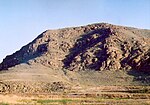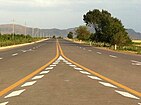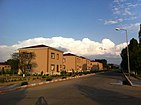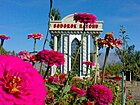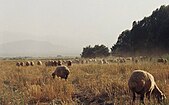Sadarak District
Sadarak District | |
|---|---|
 Map of Azerbaijan showing Sadarak District | |
| Country | |
| Autonomous Republic | Nakhchivan |
| Established | 28 August 1990 |
| Capital | Heydarabad |
| Settlements[1] | 4 |
| Area | |
• Total | 160 km2 (60 sq mi) |
| Population | |
• Total | 16,100 |
| • Density | 100/km2 (260/sq mi) |
| Time zone | UTC+4 (AZT) |
| Postal code | 7300 |
| Website | sederek-ih |
Sadarak District (Azerbaijani: Sədərək rayonu) is one of the 7 districts of the Nakhchivan Autonomous Republic of Azerbaijan. The district borders the district of Sharur, as well as the Iğdır Province of Turkey, Ararat Province of Armenia and the West Azerbaijan Province of Iran. Its capital is Heydarabad and largest settlement is Sadarak. As of 2020, the district had a population of 16,100.[2]
Sadarak is the only Azerbaijani district bordering Turkey. The Umut Bridge over the Aras, also called the "bridge of hope", links Azerbaijan with Turkey, where the Nakhchivan-Istanbul bus route passes. Sadarak District also includes the Karki exclave which has been controlled by Armenia since the First Nagorno-Karabakh War.
Etymology
There are different theories about the word's origin. Some say Sadarak means three valleys in Farsi. Indeed, there are three valleys in Sadarak: Chanagchichay, Chahannamdara, Bagirsag. Linguists link the word to "sed rang", i.e. a hundred colours. Sedrak means a place inhabited by many people in Arabic. In the 14th century, it was inhabited by the Saadli tribe. Local etymology suggests that Sadarak is made up of steel and garak (flood-prone). Researchers believe that the word relates to a place called Sakrak mentioned in the Book of Dede Korkut.[3]
History
The Barda-Erevan-Nakhchivan-Julfa-Tabriz section of the Great Silk Way linking Azerbaijan's north with Middle Eastern countries passed through Sadarak. During the 1722 attack of Peter the Great on the Caucasus, including Azerbaijan, Nakhchivan fell under the influence of the Ottomans, while following the 1828 Turkmenchay agreement it was passed on to Russia to become part of Erevan province. In a letter to Gen Paskevich from 23 September 1828, A. Griboyedov provided information about the Nakhchivan population. Under the 1828 decree of Czar Nicolas the First, the Armenian Oblast was established in part of the Armenian Highlands, on the territory of the former Erivan and Nakhchivan khanates; about 130,000 Armenians resettled there to their former homes from Iran and Turkey.
31 December 1989 saw an extraordinary event in USSR history as state borders called "the metal grating" were knocked down enabling people to cross the Aras. In early 1990, the Supreme Council of the Nakhchivan SSR passed a shocking decision to secede from the USSR. Proceeding from the Kars agreement, the autonomous republic's legislature asked Turkey, Iran, the UN and other international organizations for help. The decision came like thunder from a clear sky. It was the first time in USSR history when a decision to break away from it was passed by an autonomous republic, not even a fully-fledged republic. Sadarak acquired district status after detaching from Sharur District on August 28, 1990. On 19–20 January 1990, during the First Nagorno-Karabakh War, local Armenian forces seized Sadarak's Karki village.
Historical sites
Sadarak was an important medieval settlement on the Yerevan-Nakhchivan trade road. There are remains of the Sadarak fortress 955 meters above sea level, three medieval mosques, ruins of defence structures, a caravansary, the Agoglan shrine, and a 19-20th century bath-house here. Sadarak's archaeological sites were registered in 1958. The best-known of them is the Agoglan shrine attributed to the 7-11th centuries.
Archaeology
An important archaeological site in the district of Sadarak is an ancient settlement of Chalcolithic period that stretches over five acres. The settlement is located on the plain, east of the village of Karaagaç.[4] It is known as Kultepe Sadarak, and is of remarkable importance because of its multiple cultural layers that go back to the late Paleolithic period.
Many ceramic products were unearthed here, such as chaff faced pottery, and tableware with painted red lines. The settlement is a testimony of local culture in the V millennium BC, and it brings in new information about the Paleolithic Period in Nakhchivan.[5]
Proto Kura-Araxes pottery is found here, black-burnished pottery, as well as all the other types of Kura-Araxes pottery which followed later. Other related Nakhchivan sites with similar early pottery are Ovcular Tepesi, and Khalaj (archaeology).[4]
Geography
Sadarak District borders Turkey in the south-west (the only bordering zone with Turkey and Azerbaijan is here - 11 km), with Armenia in the north-west – 24 km and Sharur District in the south-east – 27 km.
The climate of Sadarak is continental with hot summer and cold winter. Mineral water springs similar to Istisu and Jeleznovodsk were discovered in Sadarak in 1980.
The territory of the district consists of plains, surrounded by the Ujubiz, Aghdakan, Validag and Tekgar massifs. The Aras River flows along the border between Turkey and Sadarak District.[6]
Population
According to the State Statistics Committee, as of 2018, the population of the region recorded 15.9 thousand persons, which increased by 3.7 thousand persons (30 percent) from 12.2 thousand persons in 2000.[7] 8.1 thousand of total population are men, 7.8 thousand are women.[8]
| 2000 | 2001 | 2002 | 2003 | 2004 | 2005 | 2006 | 2007 | 2008 | 2009 | 2010 | 2011 | 2012 | 2013 | 2014 | 2015 | 2016 | 2017 | 2018 | |
|---|---|---|---|---|---|---|---|---|---|---|---|---|---|---|---|---|---|---|---|
| Sadarak region | 12,2 | 12,4 | 12,5 | 12,7 | 12,9 | 13,1 | 13,4 | 13,6 | 13,8 | 14,0 | 14,1 | 14,4 | 14,6 | 15,0 | 15,3 | 15,4 | 15,6 | 15,8 | 15,9 |
| urban population | - | - | - | 0,7 | 1,3 | 1,4 | 1,4 | 1,5 | 1,5 | 1,6 | 1,7 | 2,0 | 2,0 | 2,0 | 2,1 | 2,1 | 2,1 | 2,2 | 2,2 |
| rural population | 12,2 | 12,4 | 12,5 | 12,0 | 11,6 | 11,7 | 12,0 | 12,1 | 12,3 | 12,4 | 12,4 | 12,4 | 12,6 | 13,0 | 13,2 | 13,3 | 13,5 | 13,6 | 13,7 |
Transportation
In 2023, Baku and Ankara agreed on building a railway transport between Turkey and Azerbaijan which would pass from Sadarak.[9][10][11]
Gallery
- Sadarak
- Mosque
- Mountain
- Mountain
- Sadarak
- Agoglan
- Agri Dagi
- Sadarak
- Sadarak
- Heydarabad
- Heydarabad
- Heydarabad
- Heydarabad
- Heydarabad
- Heydarabad
- Heydarabad
- Sadarak
- Sadarak School
- Sadarak
- Sadarak
References
- ^ "İnzibati-ərazi vahidləri" (PDF). preslib.az. Retrieved 28 February 2021.
- ^ a b "Population of Azerbaijan". stat.gov.az. State Statistics Committee. Retrieved 22 February 2021.
- ^ "Sadarak". discoverazerbaijan.az. Archived from the original on 2013-09-11. Retrieved 2012-08-27.
- ^ a b Bakhshaliyev, Veli; Seyidov, Abbas (2013). "New findings from the settlement of Sadarak (Nakhchivan-Azerbaijan)". Anatolia Antiqua. 21 (1): 1–21. doi:10.3406/anata.2013.1337. ISSN 1018-1946.
- ^ Nakhchivan: Development of palaeolithic and neolithic periods Archived 2019-07-25 at the Wayback Machine foreignpolicynews.org - September 07, 2016
- ^ "Садаракский район". azerbaijan.az. Archived from the original on 2018-10-18. Retrieved 2012-08-27.
- ^ a b "Political division, population size and structure: Population by towns and regions of the Republic of Azerbaijan". The State Statistical Committee of the Republic of Azerbaijan. Retrieved 2018-12-13.
- ^ "Political division, population size and structure: Population by sex, towns and regions, urban settlements of the Republic of Azerbaijan at the beginning of the 2018". Azərbaycan Respublikasının Dövlət Statistika Komitəsi (in Azerbaijani). Retrieved 2018-12-13.
- ^ "Baku, Ankara agree on construction of Kars- Nakhchivan railroad, green energy sales from Azerbaijan to Turkey". interfax.com. Retrieved 2023-12-20.
- ^ Şafak, Yeni. "Kars-Nahçıvan Demiryolu Projesi ile ilgili fizibilite çalışmalarının sürdürülmesi kararı alındı | Türkiye Ekonomisi Haberleri". Yeni Şafak (in Turkish). Retrieved 2023-12-20.
- ^ "Əli Əsədov Cevdet Yılmazla Qars-Naxçıvan dəmir yolunun əhəmiyyətindən DANIŞDI - FOTO". bizim.media (in Azerbaijani). Retrieved 2023-12-20.



